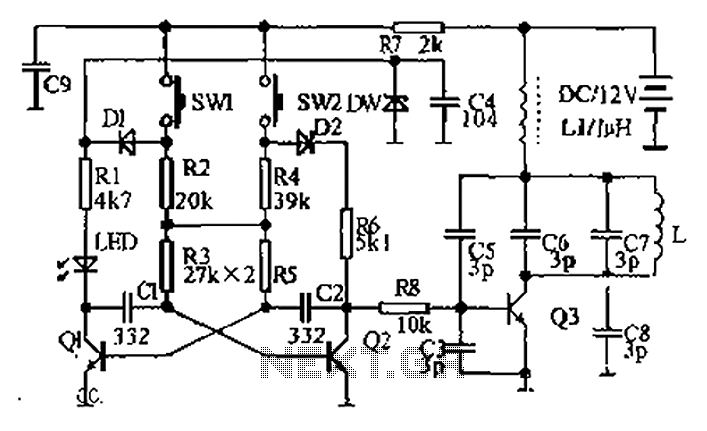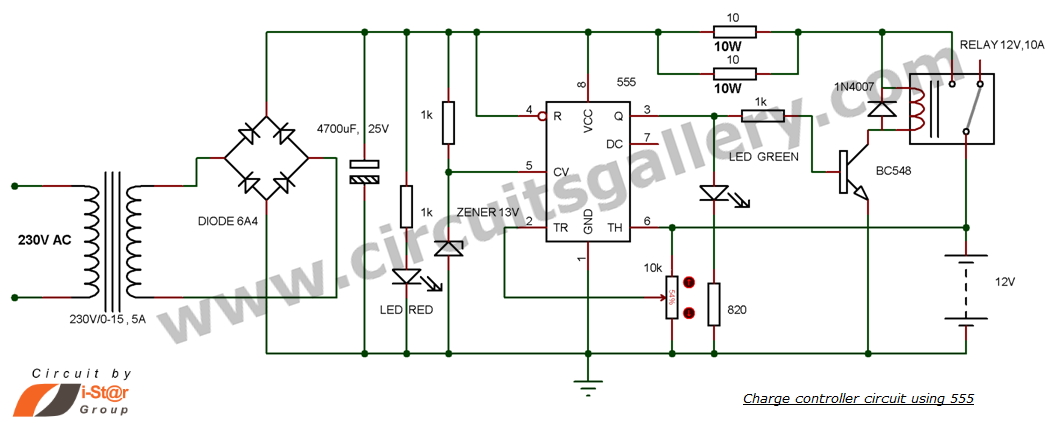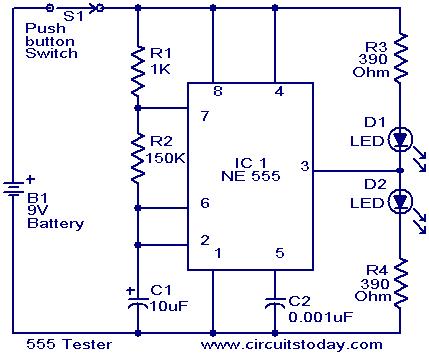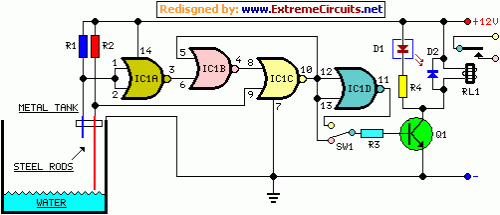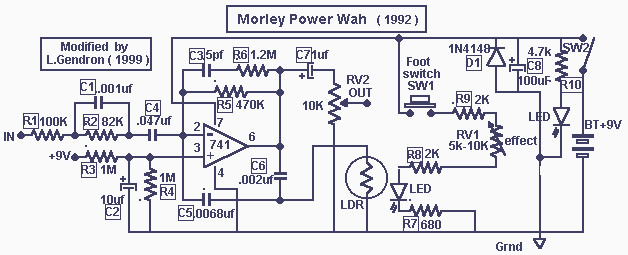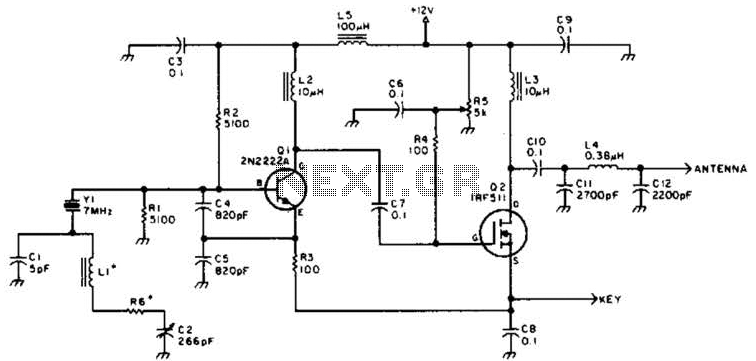
Eight outputs flash circuit diagram
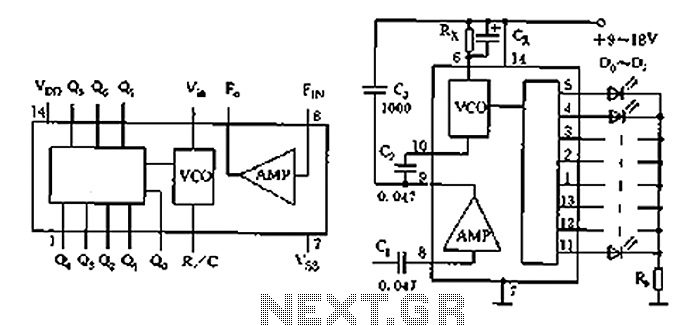
The circuit shown is a lighting control circuit that adjusts the speed of the flash output based on the strength of an audio signal. It utilizes eight flash integrated circuits (ICs) of the type LP188, which is housed in a 14-pin dual in-line plastic package. The internal logic diagram indicates that pins 14 and 7 are connected to the positive and negative power supply, respectively. Pin 6 serves as the input for the voltage-controlled oscillator (VCO), while pins 8 and 9 are designated for the input and output of the audio amplifier. The outputs, labeled Q0 to Q5, represent the eight flash outputs. The circuit operates with a power supply voltage ranging from 9V to 18V, with the audio amplifier providing a gain of 100dB. The input signal for the audio amplifier is 0.5V peak-to-peak, and the VCO input signal is 1.5V peak-to-peak. Each flash output can deliver a current greater than 20mA, and the modulation rate of the frequency can vary from 1 to 20 times. The flash circuit, as depicted in Figure B, is coupled from capacitor C1 to the audio signal amplifier and controls the oscillation frequency of the VCO. The amplitude of the input signal determines the oscillation frequency; a higher amplitude results in a faster oscillation frequency, while a lower amplitude results in a slower frequency. The modulation rate, ranging from 1 to 20 times, is influenced by resistors Rx and capacitors Cx, where Rx can be selected between 470k ohms to 1.5M ohms, and Cx can range from 1 to 2 microfarads. A current-limiting resistor R is used to control the operating current. The flash patterns can be customized, and outputs can be connected in parallel; for instance, Q0 with Q4, Q1 with Q5, Q2 with Q6, and Q3 with Q7 can be paralleled to create four decorative flashing circuits. Component selection includes standard luminous tubes for D0 to D7, and the resistance for R0 should be between 10 to 30 ohms.
This lighting control circuit is designed to provide a dynamic visual experience by synchronizing light flashes with audio signals. The LP188 flash ICs are the core components that facilitate this synchronization, allowing for a variety of flash patterns based on the audio input's amplitude. The circuit's operational range of 9V to 18V ensures compatibility with various power sources, making it suitable for different applications, including decorative lighting and event displays.
The audio amplifier's gain of 100dB allows it to effectively amplify low-level audio signals, ensuring that even subtle changes in the audio input can influence the flash frequency. The VCO's responsiveness to the audio signal's amplitude enables the circuit to produce a wide range of flash speeds, enhancing the visual impact of the lighting.
The selection of components, such as the resistors and capacitors, is critical for achieving the desired performance. The choice of Rx and Cx values directly affects the modulation rate and oscillation frequency, allowing for fine-tuning of the circuit's response to audio signals. The ability to customize flash patterns by paralleling outputs provides flexibility in design, enabling the creation of unique lighting effects tailored to specific applications.
Overall, this circuit exemplifies an innovative approach to integrating audio and visual elements, making it a valuable tool for creating engaging and interactive lighting displays. As shown in the circuit is a state of the flash output can change the speed of lighting control circuit according to the strength of eight timing of the audio signal. Circuit p rinciple: This circuit uses eight flash IC assembled LP188, LP188 uses 14-pin dual in-line plastic package. Its internal logic diagram shown in a, the circuit of 14 feet and 7 feet, respectively positive and negative power supply, 6 feet R/C is a voltage controlled oscillator input, 8 feet and 9 feet for the input and output of audio amplifier, Q0 ~ Q5 are eight flash output.
Circuit power supply voltage is 9 ~ 18V; audio amplifier gain of 100dB, audio amplifier input signal 0.5Vpp, voltage controlled oscillator input signal 1.5Vpp, flash Each output current greater than 20mA, voltage controlled frequency modulation rate 1-20 times. Figure b flash circuit coupled from the C1 to the audio signal amplifier and control the voltage-controlled oscillator (VCO) the oscillation frequency.
Input signal amplitude, fast oscillation frequency, otherwise slow. Modulation rate of between 1 to 20 times, the oscillation frequency is determined by Rx and Cx, Rx can be 470k Euro ~ 1.5M Europe, Cx at 1 ~ 2uF value between the current limiting resistor R limit the size of the current work in every way. Flash shape can be edited as desired group, whose output can also be used in parallel, if Q0Q4, Q1Q5, Q2Q6, Q3Q7 output terminal in parallel, can be constructed four decorative fun flash circuit.
Component selection: D0 ~ D7 optional ordinary luminous tube, R0 ranging between 10 to 30 ohms.
This lighting control circuit is designed to provide a dynamic visual experience by synchronizing light flashes with audio signals. The LP188 flash ICs are the core components that facilitate this synchronization, allowing for a variety of flash patterns based on the audio input's amplitude. The circuit's operational range of 9V to 18V ensures compatibility with various power sources, making it suitable for different applications, including decorative lighting and event displays.
The audio amplifier's gain of 100dB allows it to effectively amplify low-level audio signals, ensuring that even subtle changes in the audio input can influence the flash frequency. The VCO's responsiveness to the audio signal's amplitude enables the circuit to produce a wide range of flash speeds, enhancing the visual impact of the lighting.
The selection of components, such as the resistors and capacitors, is critical for achieving the desired performance. The choice of Rx and Cx values directly affects the modulation rate and oscillation frequency, allowing for fine-tuning of the circuit's response to audio signals. The ability to customize flash patterns by paralleling outputs provides flexibility in design, enabling the creation of unique lighting effects tailored to specific applications.
Overall, this circuit exemplifies an innovative approach to integrating audio and visual elements, making it a valuable tool for creating engaging and interactive lighting displays. As shown in the circuit is a state of the flash output can change the speed of lighting control circuit according to the strength of eight timing of the audio signal. Circuit p rinciple: This circuit uses eight flash IC assembled LP188, LP188 uses 14-pin dual in-line plastic package. Its internal logic diagram shown in a, the circuit of 14 feet and 7 feet, respectively positive and negative power supply, 6 feet R/C is a voltage controlled oscillator input, 8 feet and 9 feet for the input and output of audio amplifier, Q0 ~ Q5 are eight flash output.
Circuit power supply voltage is 9 ~ 18V; audio amplifier gain of 100dB, audio amplifier input signal 0.5Vpp, voltage controlled oscillator input signal 1.5Vpp, flash Each output current greater than 20mA, voltage controlled frequency modulation rate 1-20 times. Figure b flash circuit coupled from the C1 to the audio signal amplifier and control the voltage-controlled oscillator (VCO) the oscillation frequency.
Input signal amplitude, fast oscillation frequency, otherwise slow. Modulation rate of between 1 to 20 times, the oscillation frequency is determined by Rx and Cx, Rx can be 470k Euro ~ 1.5M Europe, Cx at 1 ~ 2uF value between the current limiting resistor R limit the size of the current work in every way. Flash shape can be edited as desired group, whose output can also be used in parallel, if Q0Q4, Q1Q5, Q2Q6, Q3Q7 output terminal in parallel, can be constructed four decorative fun flash circuit.
Component selection: D0 ~ D7 optional ordinary luminous tube, R0 ranging between 10 to 30 ohms.
